Noynoy Aquino’s rule: Numbers tell part of the story
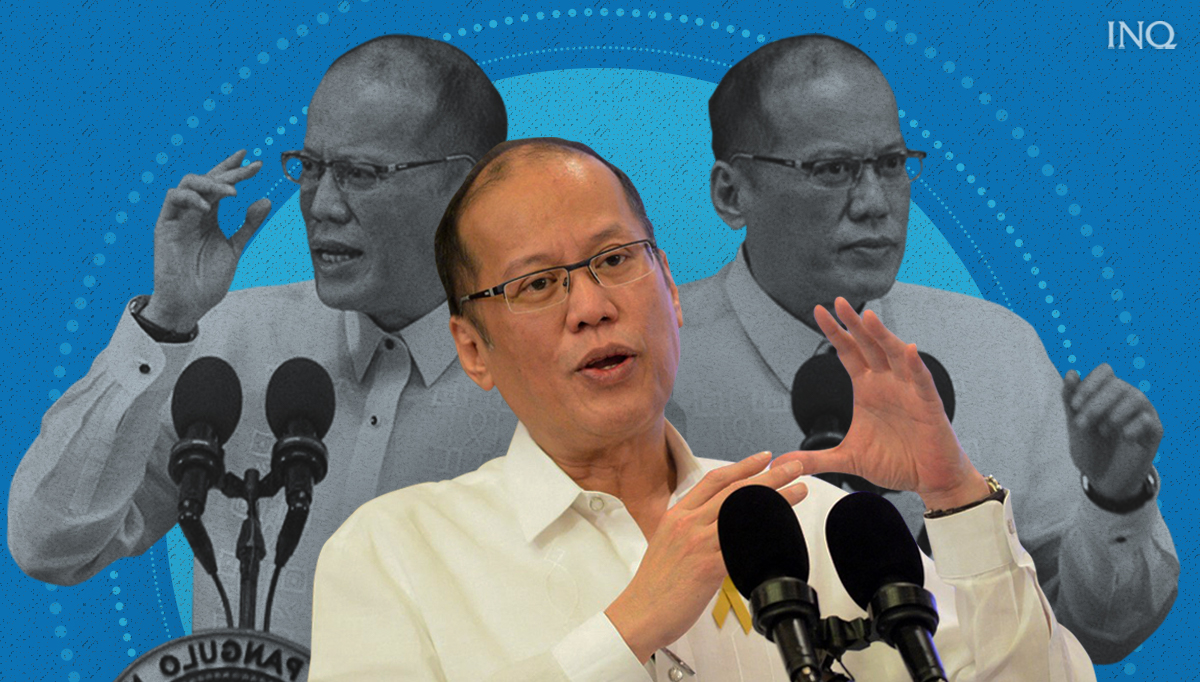
MANILA, Philippines—What Benigno S. Aquino III achieved as President from 2010 to 2016 could vary depending on which side of the current political fence the observer is standing.
But data from the government and other records would show numbers that could speak on their own about the late former President’s governance.
Economic growth
During Aquino’s term, the Philippine economy had its time in the spotlight with numbers not seen before.
The Aquino legacy: solid macroeconomy, healthy finances
The country’s GDP growth averaged 6.2 percent yearly under Aquino.
From a 3.6 percent growth in 2011, GDP grew by 6.8 percent in 2012 and further increased to 7.8 percent in the first quarter of 2013—the highest growth rate under Aquino and faster than that of China’s, Indonesia’s, Thailand’s and Vietnam’s for the same period.
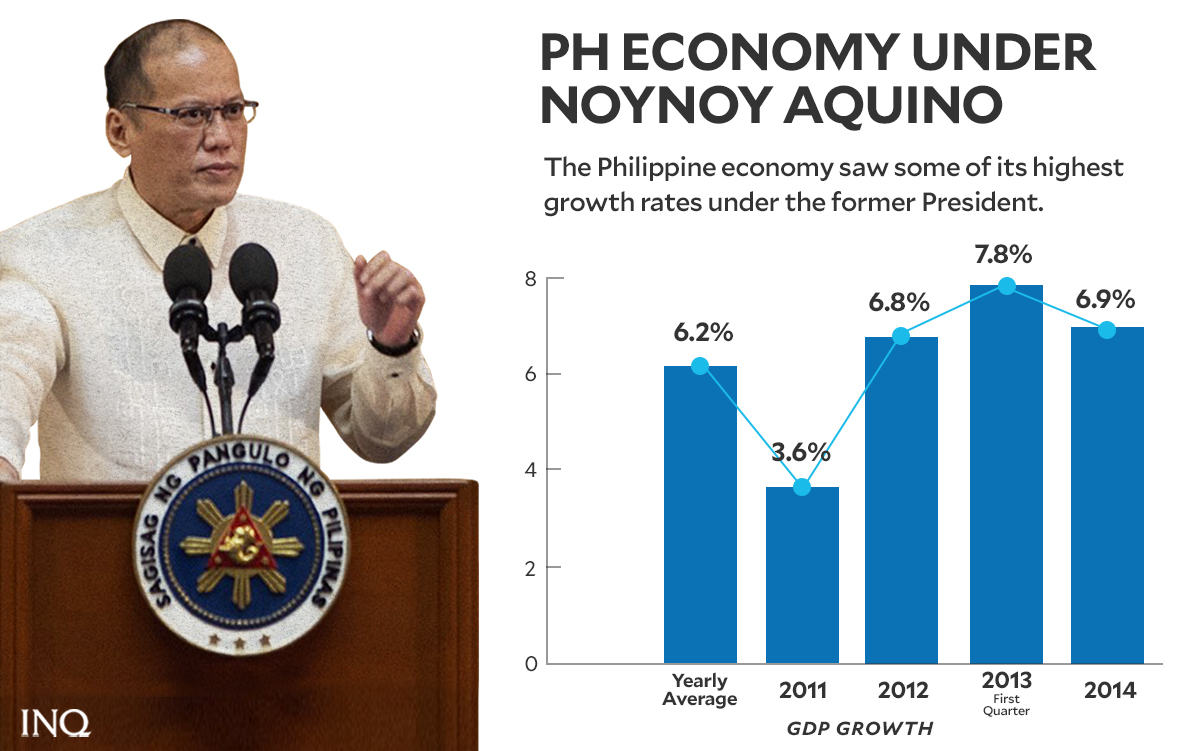
GRAPHIC BY ED LUSTAN
In 2016, a few months before Aquino stepped down, Philippine economic growth was 6.9 percent, the fastest among 11 Asian economies during that year’s first three months.
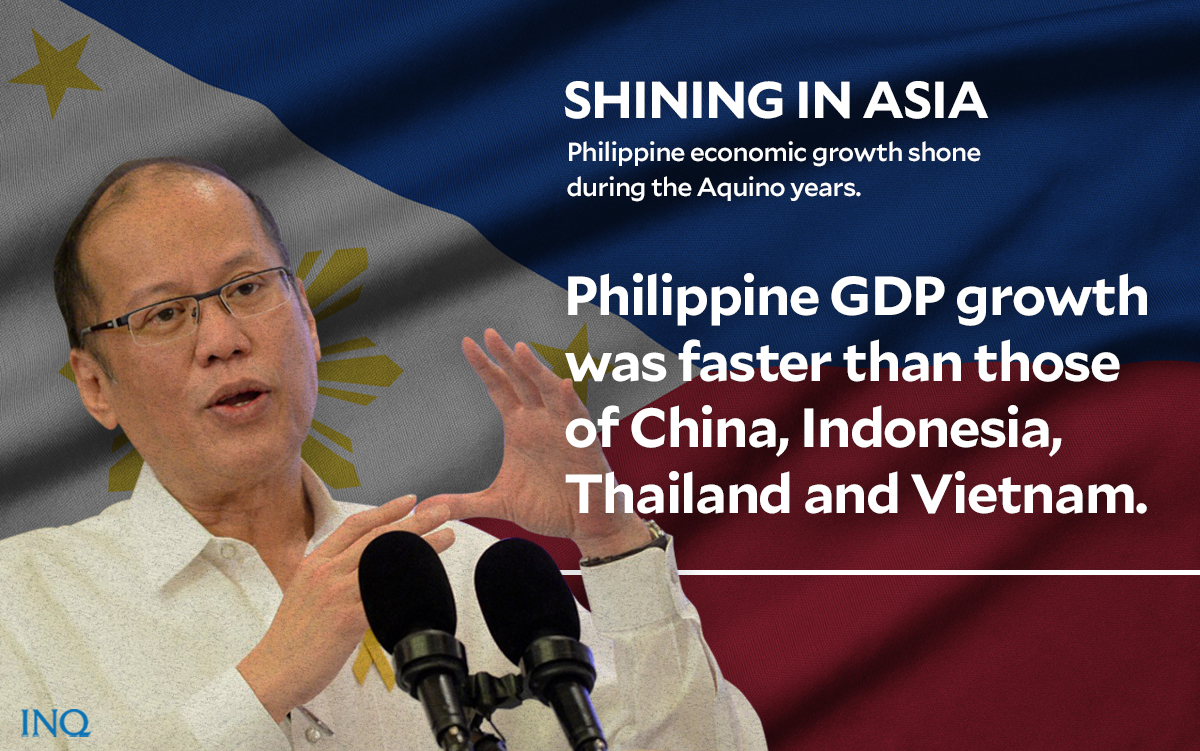
GRAPHIC BY ED LUSTAN
PH GDP grew 6.9% in Q1, fastest growth since Q2 of 2013
Inflation, investments
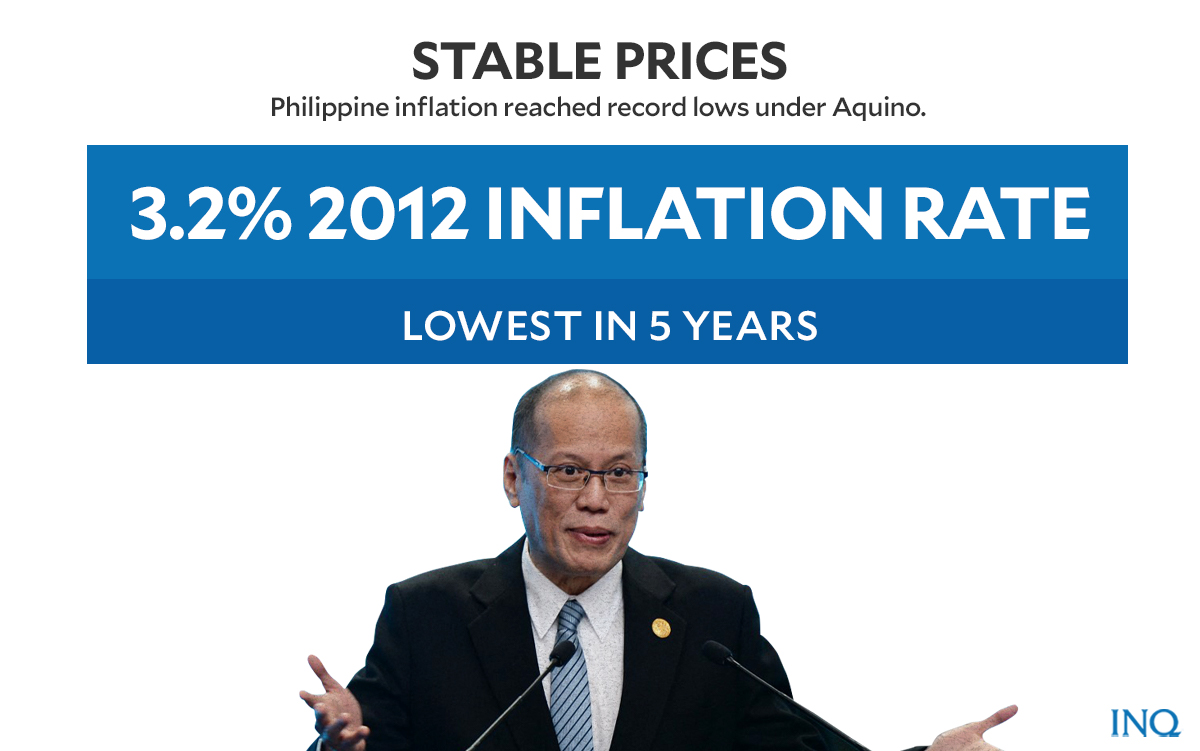
GRAPHIC BY ED LUSTAN
Prices had been stable for most of the time under Aquino. Average inflation rate dipped at 3.2 percent in 2012, the lowest in five years.
The Philippines also got its first investment-grade credit rating of BBB- from Fitch Ratings and Standard & Poor on March 27 and May 2, 2013.
The Japan Credit Rating Agency Ltd. (JCR) also raised its rating for the Philippines by a notch from the minimum investment grade of BBB- to BBB in the same year.
In 2015, the Philippines secured its highest credit score from JCR at BBB+ or just a notch below the minimum in the “A” category sovereign rating.
PH credit rating raised to BBB+
The Philippines’ ranking in the World Economic Forum’s (WEF) Global Competitiveness Report also consistently improved under Aquino. The global competitiveness rating is a measure of investment attractiveness, ease of business and other indicators of a nation’s worthiness as an investment destination.
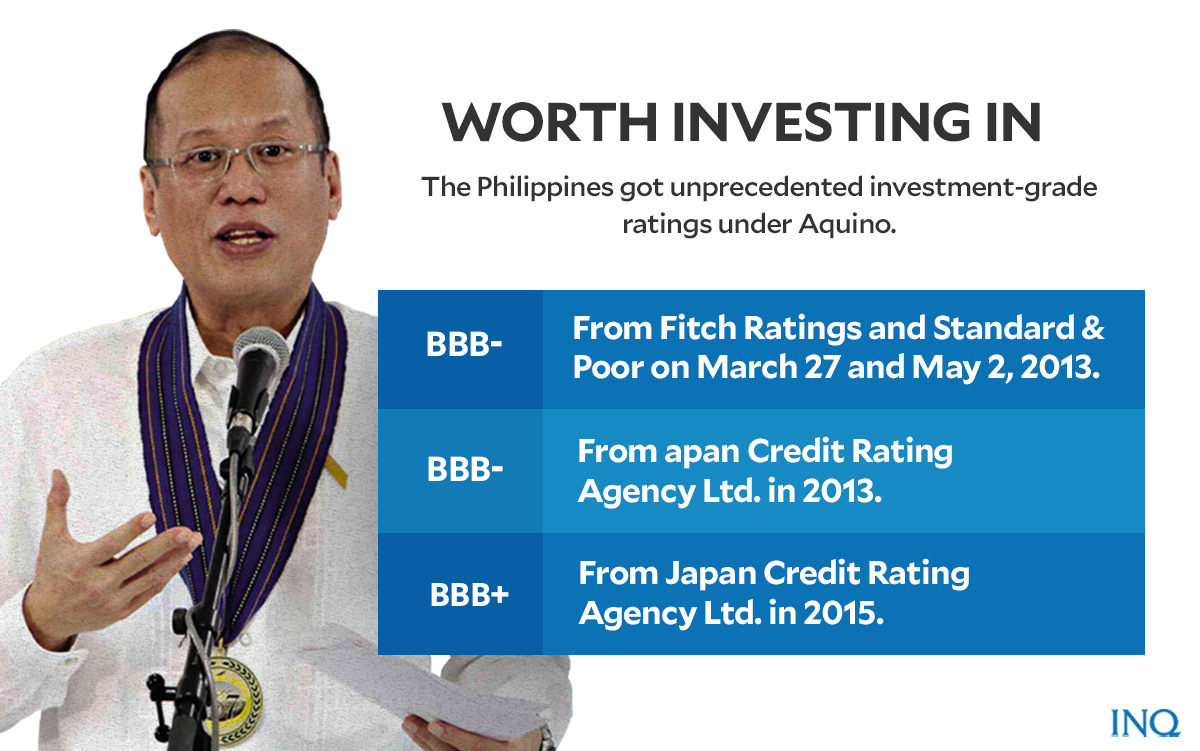
GRAPHIC BY ED LUSTAN
In 2011, the Philippines jumped 10 notches to the 75th spot among 144 countries in competitiveness. In 2012, the Philippines jumped to 65th place.
PH competitiveness ranking up by 10 notches
The Philippines moved further up on the list to 59th place in 2013 while in 2014, the Philippines climbed seven places to 52nd place.
In 2015, the Philippines ranked 47th, which was the fifth highest-ranking among Asean countries.
PH up 5 notches in competitiveness ranking
From 2010 to 2015, the Philippines has climbed a total of 38 spots in competitiveness.
Infra projects
Contrary to claims by critics of Aquino, under his administration, the government was able to approve and complete key private partnership projects before his term ended in 2016.
According to a report by the Public-Private Partnership Center (PPC), three infrastructure projects have completed construction in 2015.
These were:
- Daang Hari-SLEX Link Road (Muntinlupa-Cavite Expressway). Operational since July 24, 2015
- Phase 1 of the School Infrastructure Project—A total of 9,296 classrooms were constructed as of Dec. 4, 2015
- Automatic Fare Collection System for Metro Manila’s train lines (also known as Beep card)—Operational as of Dec. 16, 2015
A separate list in the Official Gazette showed projects that had been approved during Aquino’s term that were completed by his successor, President Rodrigo Duterte.
Among these were the second phase of Naia Expressway, which started in 2012 and was completed a few months before Aquino stepped down.
Several projects in the National Capital Region (NCR) approved under Aquino and were partly finished and became operational after his term were:
- NLEX Harbor Link
- Pasig Marikina River Channel
- Southwest Intermodal Terminal
- C5 South Link Expressway
- LRT Line 2 East Extension Project
- NLEX Harbor Link Segment 8.2
- Metro Rail Transit (MRT) Line 7
- Light Rail Transit (LRT) Line 1 South Extension Project
Some of the projects approved by Aquino are now on the list of projects under Duterte’s infrastructure centerpiece, “Build, Build, Build.”
Landmark legislation
Aquino has also signed several historic measures into law.
Among the landmark laws signed during the Aquino administration were:
- Sin Tax Reform Act
- K to 12 program or the Enhanced Basic Education Curriculum
- Responsible Parenthood and Reproductive Health Act of 2012
Aquino also signed into law several measures for multi-sectoral reforms including:
- The Anti-Enforced or Involuntary Disappearance Act
- The Human Rights Victims Reparation and Recognition Act of 2013
- The Expanded Anti-Trafficking in Persons Act of 2012
- The Domestic Workers Act or Batas Kasambahay
- The AFP Modernization Act
- The National Electrification Administration Reform Act of 2013
- The National Health Insurance Act of 2013
Programs focused on the environment and climate change, like Project NOAH and the National Green Program, were also introduced during the late president’s term.
Underspending
When the Duterte administration took over in 2016, it was left with a P1 trillion budget after the Aquino administration failed to spend it on appropriated items.
According to data from then Budget Secretary Benjamin Diokno, P1.02 trillion worth of notices of cash allocation (NCA) was left untouched.
According to a report by the Department of Budget and Management (DBM) the underspending—on infrastructure and other capital outlays—was largely due to the ban on projects immediately preceding an election.
Fight against corruption
The anti-corruption campaign was a central part of the late president’s platform of government. During Aquino’s term, several top officials, including three senators, a former national police chief and his predecessor, Gloria Macapagal Arroyo, were arrested for graft-related cases.
Aquino’s promise to stop corruption, however, was smeared by the now infamous pork barrel scam, which his critics said involved many Aquino allies that have been spared from prosecution. The scam’s mastermind, Janet Lim Napoles, is now in jail, though.
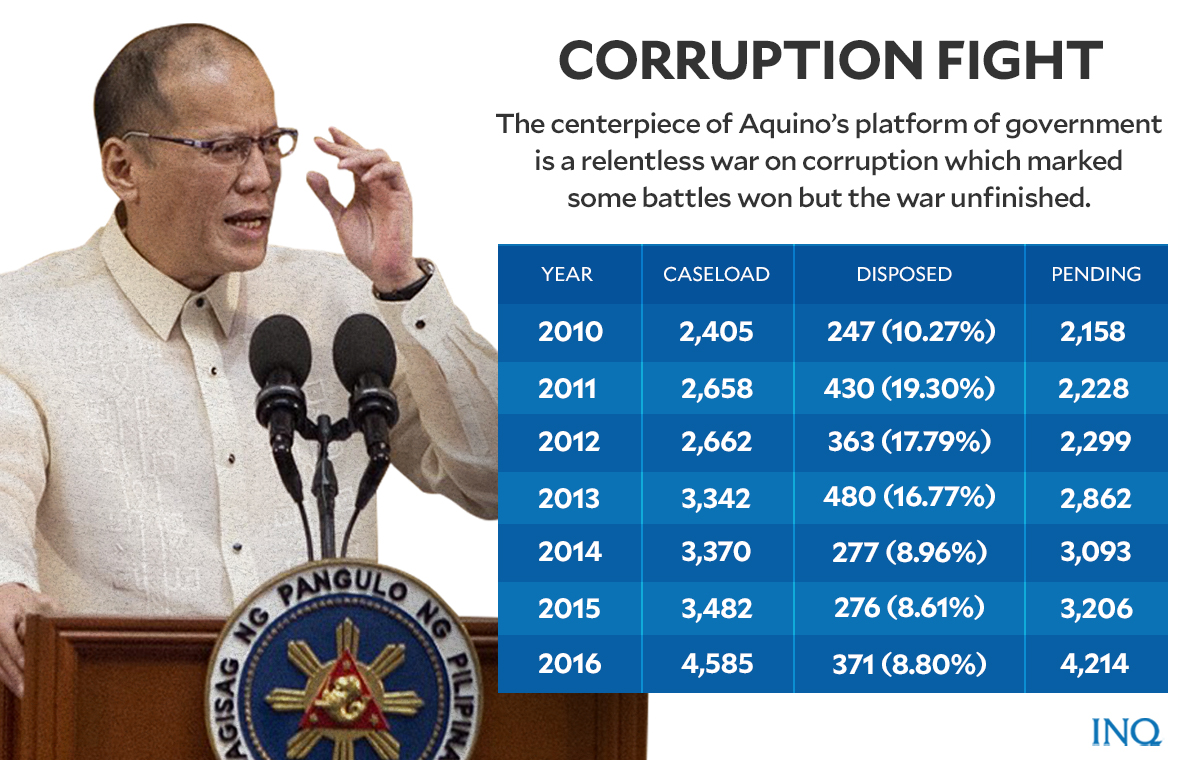
GRAPHIC BY ED LUSTAN
The numbers would also show an anti-corruption policy that appeared to be faltering in implementation.
According to anti-graft court Sandigandayan, from 2010 to 2016, the number of cases that had been disposed of was barely 20 percent of total. The highest number of resolved cases came in 2011—430 or 19.30 percent of a total 2,228.
The slow pace in the disposition of cases has led to the signing by Aquino of Republic Act No, 10660 in April 2015, which aimed to strengthen the capacity of the Sandiganbayan to resolve corruption cases.
Aquino OKs new Sandiganbayan divisions
The law increased the number of divisions in the anti-graft court from five to seven in a bid to ease the court’s backlog.
The new law also made it easier for the Sandiganbayan to constitute a quorum of justices. It allowed a quorum of just three justices in a division instead of five, making it quicker for cases to move forward and eliminate the excuse of lack of quorum in delay of cases.
It also sought to reduce the backlog of cases in the anti-graft court by giving jurisdiction to the regional trial courts over cases that do not involve more than P1 million in damage to the government.
Despite the passage of the law, toward the end of the Aquino administration, there were still at least 4,214 pending cases at the Sandiganbayan—double the amount of pending cases in 2010.
While data from the Sandiganbayan showed unimpressive numbers, international investors found improvements in the government’s efforts to tackle and address corruption.
Aquino’s corruption fight marks modest progress –experts
The Philippines’ ranking in the Worldwide Governance Indicators (WGI) under the Control of Corruption category has been consistently in the top 50 out of 213 countries worldwide.
WGI, a project of the World Bank and the Brookings Institution, assesses countries’ quality of governance based on six different categories.
The Control of Corruption category measures the “perceptions of the extent to which public power is exercised for private gain, including both petty and grand forms of corruption, as well as ‘capture’ of the state by elites and private interests.”
In Transparency International’s Corruption Perception Index, a widely used yardstick, the Philippines’ ranking also improved from 2010 to 2015.
Controversies
Like all other administrations, Aquino’s has had its share of controversies and scandals.
Among these were:
- The Luneta hostage crisis on Aug. 23, 2010 when a dismissed policeman took a busload of Hong Kong tourists hostage in Manila, in a desperate attempt to be reinstated after losing his job over corruption allegations. The gunman and eight hostages were killed in a bungled police rescue operation. It was considered one of the major crises Aquino faced as newly-elected president.
READ: What Went Before: Manila bus hostage crisis
- Aquino’s response to Super Typhoon Yolanda (Haiyan), the strongest typhoon ever recorded to hit land at the time, which ravaged the city of Tacloban. At least 7,350 people died or went missing following the devastation.
READ: Aquino: Curse me, criticize me but I must do right thing
- The Mamasapano massacre of 44 Special Action Force (SAF) commandos during an otherwise successful operation to capture international terrorist and bomb maker Marwan on Jan. 25, 2015.
READ: Full report: The Mamasapano incident
- The beheading of Canadian retiree John Ridsdel by the homegrown terror group Abu Sayyaf which prompted an angry reaction from Canadian Prime Minister Justin Trudeau.
READ: Beheaded despite P20-M ransom
When Aquino retired from the presidency, he kept a low profile as a private citizen.
Instances when he was seen in public were few. These included his presence in February 2017 at the commemoration of the 31st anniversary of the Edsa People Power Revolt that toppled the Marcos dictatorship.
In July 2020, the Office of the Ombudsman indicted Aquino for usurpation of authority and graft for his alleged role in the operation to get Marwan that killed 44 SAF members.
In 2021, Aquino was charged with usurpation of legislative powers over the controversial Disbursement Acceleration Program (DAP), which converted government savings into disbursable funds for projects other than those for which these had been allotted.
In 2019, however, he made several public appearances starting in March when he campaigned for the opposition Senate ticket Otso Diretso during the May elections that year.
In November 2019, he also attended Mass for the 1,000th day of Leila de Lima’s continued detention.
Last December, the former president was hospitalized and admitted to ICU but was released after a few weeks.
READ: Life after the presidency of Duterte predecessors: VP run not included
In his words
Aquino has drawn a mix of irritation, fascination, admiration and scorn with his public statements.
Among those are these memorable lines:
- “Kung walang corrupt, walang mahirap.” “Daang matuwid.”—Aquino’s famous catchphrases and anti-corruption slogans
- “My father offered his life so our democracy could live. My mother devoted her life to nurturing that democracy. I will dedicate my life to making our democracy reach its fullest potential—that of ensuring equality for all. My family has sacrificed much and I am willing to do this again if necessary”—part of Aquino’s inaugural address in June 2010.
- “I can forgive those who did me wrong but I have no right to forgive those who abused our people. There can be no reconciliation without justice. When we allow crimes to go unpunished, we give consent to their occurring over and over again.”—Aquino in his inaugural address in June 2010.
- “Kayo ang boss ko, kaya’t hindi maaaring hindi ako makinig sa mga utos ninyo.”—Aquino in his inaugural address in June 2010.
- “The Filipino is worth dying for. The Filipino is worth living for. If I may add, the Filipino is worth fighting for.”—Aquino in his 2014 Sona.
- “Mga Boss, aaminin ko, ni minsan po, hindi ko sinabing ako’y perpekto. Minsan, binigo tayo ng ilang inasahan nating alam dapat ang kanilang trabaho. Hinihingi ko po muli ang inyong pag-unawa sa mga bagay na ito. Sa kabila nito, mahaharap ko ang sinoman at masasabing: Ginawa ko ang pinakamainam na desisyon batay sa kaalaman at kakayahang mayroon tayo sa panahong iyon. Kaisa-isang interes ko ang kapakanan ng aking Boss.”—Aquino in his 2015 Sona.
- “I will not let peace be snatched from my people again.”—Aquino speech at signing of peace agreement with MILF.
- “Eh ‘di wow!”—Aquino responding to critics during his last Sona
- “I will preempt the question and say, for the record: yes, my love life is still like Coke Zero. I hope that when I step down from the presidency, it will at least go back to being like Coke Light.”—Aquino, a bachelor, said in a speech at the inauguration of a Coca-Cola plant in Laguna in 2014.
- “All I can say is at the end of the day, when I go home and I’m about to sleep, if I look at myself in the mirror, I can honestly say that I did my all on that particular day. And each and every day, that is the mantra.—Aquino at the 2015 Focap presidential forum